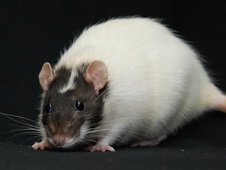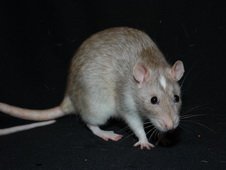Varieties
Berkshire (shown in Berkshire/Badger)
To be symmetrically marked, with as much white on the chest and belly as possible. The white shall not extend up the sides of the body; the edges shall be clear cut and devoid of brindling. Back feet to be white to the ankle, forelegs to be white to half the leg. Tail to be white up to a third of its length. The body colour shall conform to the recognised colour variety. The white area shall be pure and devoid of any colour or staining. A white spot on the forehead is desirable. Suspenders to be allowed providing they are symmetrical.

Badger (shown in Berkshire/Badger)
As much of the underside of the rat as possible to be white, including belly, chest, throat and underside of the legs, the white not to extend up the sides of the body. Back feet to be white to the ankle, forelegs to be white to the elbow. Tail to be white up to a third of its. The body colour shall conform to a recognised colour variety. The white area shall be pure and devoid of any colour or staining. The defining feature of this variety is the blaze. This is to be a wedge shaped symmetrical blaze of white starting at the nose and extending up the face to the forehead. The blaze to cover the whisker bed and taper to a fine point midway between the eyes and the ears. Markings not to extend onto the cheeks or the eyes.

Irish
White equilateral triangle on chest with front feet white and back feet white to half their length. The triangle to be of good size, clear cut and devoid of brindling, not to extend in a streak down the belly but to occupy all the space between the front legs. The body colour shall conform to a recognised colour variety.

Hooded
The hood shall be unbroken, covering the head, throat, chest and shoulders, except in the case of light coloured hooded varieties where a pale coloured throat and chest is permissible. The hood shall be continuous with the saddle (spinal stripe) which should extend down the spine to the tail, with as much of the tail as possible being coloured. The saddle width shall be 1-3cm, dependent on the size of the rat - it must be as even as possible and unbroken. The edges of the hood and saddle shall be clear cut and devoid of brindling. The white area shall be pure and devoid of any yellowish tinge or staining.

Variegated
The head and shoulders to be of a distinct colour with a white spot or blaze on the forehead. Where a spot is present this should be centrally placed on the forehead, round or oval in shape and no bigger than the rat's eye. Blazes are a wedge shaped symmetrical blaze of white starting at the nose and extending up the face to the forehead. The blaze to cover the whisker bed and taper to a fine point midway between the eyes and the ears. Markings not to extend onto the cheeks or the eyes. The rest of the upper portion (back, sides and tail) of the rat's body to be white, evenly marked with patches and flecks of distinct colour, the colour to conform to a recognised colour variety. Underside (including belly, chest and throat) to be white, devoid of creamy tinge or staining.

Capped
The colour not to extend past the ears and to follow the line of the lower jaw bone, it should not extend under the chin. A white blaze or spot on the face, and the rest of the body white, the cap to be complete between the ears and not notched, although a minor notch should not be penalised over harshly. Colour to conform to a recognised colour variety. White area should be pure and devoid of yellowish tinge and staining.

Essex
To be recognised in any standard colour, remembering that the effect of the gene responsible is to lighten the top colour. The darkest area is along the spine, becoming less intense down the sides of the animal. The gradual fading of colour continues onto the belly which is off white, with no spotting of darker colour. When viewed from above, the fading effect should be symmetrical, having no clear demarcation. The fading effect also to be seen on the legs so that the feet are also off white. There should be no obvious patches of contrasting colour. Pied tails not to be penalised. A head spot is essential; this must be well defined, centrally placed on the forehead and symmetrical.

Blazed Essex (shown in Essex class)
Blazed as in badger standard. Essex as in Essex standard.

Chinchilla
Top colour grey, caused by the intermingling of black guard hairs over a pearl white ground. The whole to give a sparkling appearance. Undercolour dark slate blue, intermediate portion pearl, tips black. The entire underside to be white with a clear demarcation between top colour and belly. Head markings may be present or absent. Where present either a blaze or a spot to be acceptable. The standard for both is as follows:
Head spot: Head spots to be centrally placed on the rat's forehead and no bigger than the rat's eye.
Blaze: Blaze to be a wedge shaped symmetrical blaze of white starting at the nose and extending up the face to the forehead. The blaze to cover the whisker bed and to taper to a fine point midway between the eyes and the ears. Markings not to extend onto the cheeks or the eyes.
Forelegs to be white to half their length, back feet white to the ankle (hock or tarsal bone). Tails to be pied.
Faults: Drags, yellow or brown tinge to the top colour, skewed or misshapen blazes, uneven or over large head spots.

Squirrel
Top colour silver blue, caused by the intermingling of blue guard hairs over a pearl white ground. Undercolour slate blue, intermediate portion pearl, tips blue. Underside to be white with a clear demarcation between top colour and belly. Head markings may be present or absent. Where present either a blaze or a head spot to be acceptable. Blazes to conform to the standard for a blaze, head spots to be centrally placed and not to be larger than the rat's eye. Forelegs to be white to half their length, back feet white to ankle (hock). Tails are pied.
Faults: drags, yellow or brown tinge to the top colour, skewed or misshapen blazes, uneven or overlarge head spots.

Roan (Husky) (shown in Roan/Striped Roan)
A strikingly marked bi-colour variety, with roan colouration, symmetry and contrast being important impressions. Clearly distinct from existing marked varieties. Roans are born solid coloured, but from the age of about 4-6 weeks they start to exhibit roaning. This is a steady increase in the number of white hairs intermingled with the solid colour, starting with the face, sides and tail root on the juvenile, then working its way up to the nape of the neck with the moult. With each moult the rat becomes progressively lighter, the final effect not really complete until the rat is well into adulthood. The roan effect is most pronounced on the face, around the rump and the sides. Pattern: The Roan shall have as symmetrical markings as possible. The underside should be completely white.
Head: A wide inverted V shaped blaze, including the whisker bed, coming as close to the eyes as possible without touching the eyes, and coming to a point between the ears. Jaw line and underside of the head must be white. Eye colour to conform to base colour standard.
Body: From the head, the colour runs back covering the ears and continues along the body extending down the sides. Belly to be white.
Tail: Unmarked tail preferred.
Faults: White spots in coloured fur/ coloured spots in white fur. Brindled demarcation line. Lack of white on face and head or a completely white face or head.

Striped Roan (Banded Husky) (shown in Roan/Striped Roan)
A strikingly marked bi-colour variety with roan colouration, symmetry and contrast being important impressions. Clearly distinct from existing marked varieties.
Pattern: The striped Roan shall have as symmetrical markings as possible. The chest, belly, sides and all the legs to be completely white.
Head: A wide inverted V shaped blaze including the whisker bed, coming as close to the eyes as possible without touching the eyes, and coming to a point between the ears. Jaw line and underside of the head must be white. Eye colour to conform to the standard for the base colour.
Body: From the head, the colour runs back covering the ears and continues along the body with no suggestion of a hood, in an unbroken horizontal stripe, symmetrical and as straight as possible. The stripe to be approximately 5cm wide. Demarcation shall be as clear cut and even as possible.
Tail: Unmarked preferred.
Faults: White spots in coloured fur/coloured spots in white fur. Brindled demarcation line, demarcation line too low. Lack of white on face or a completely white face. Stripe too narrow or broken, any suggestions of a hood.
